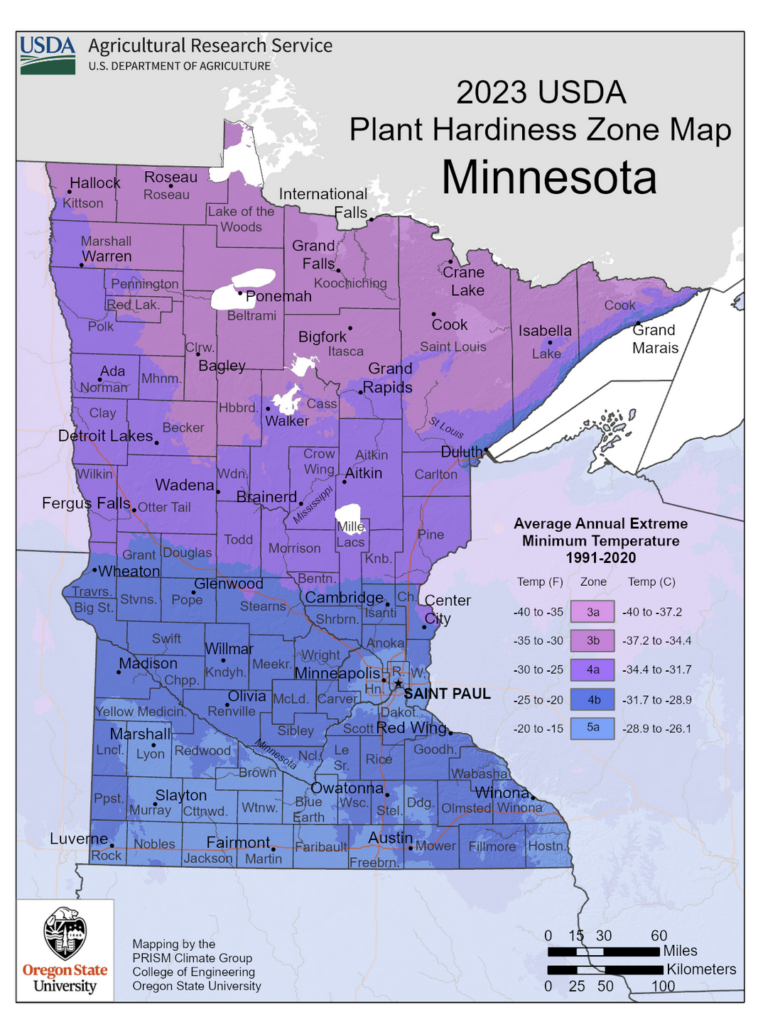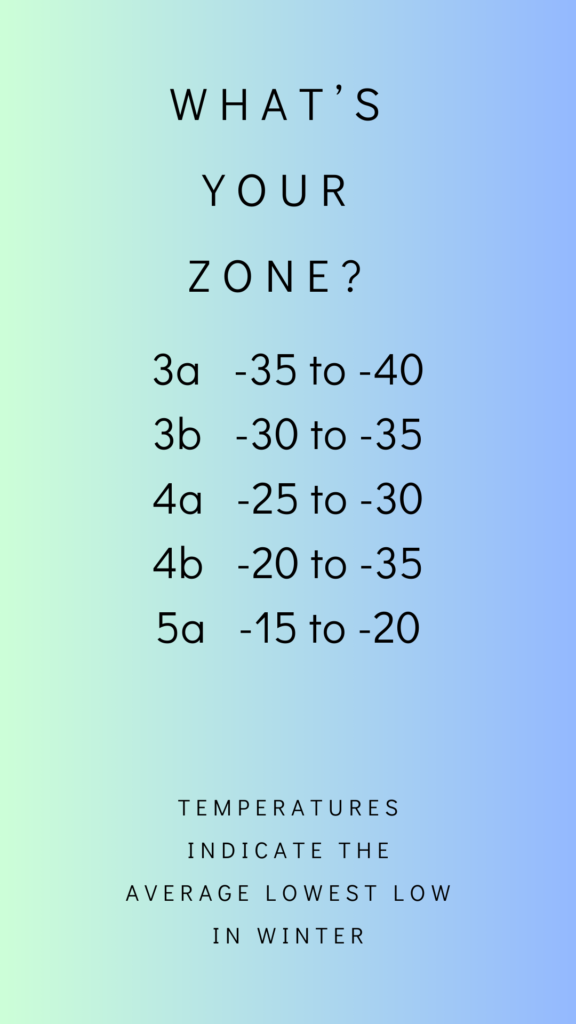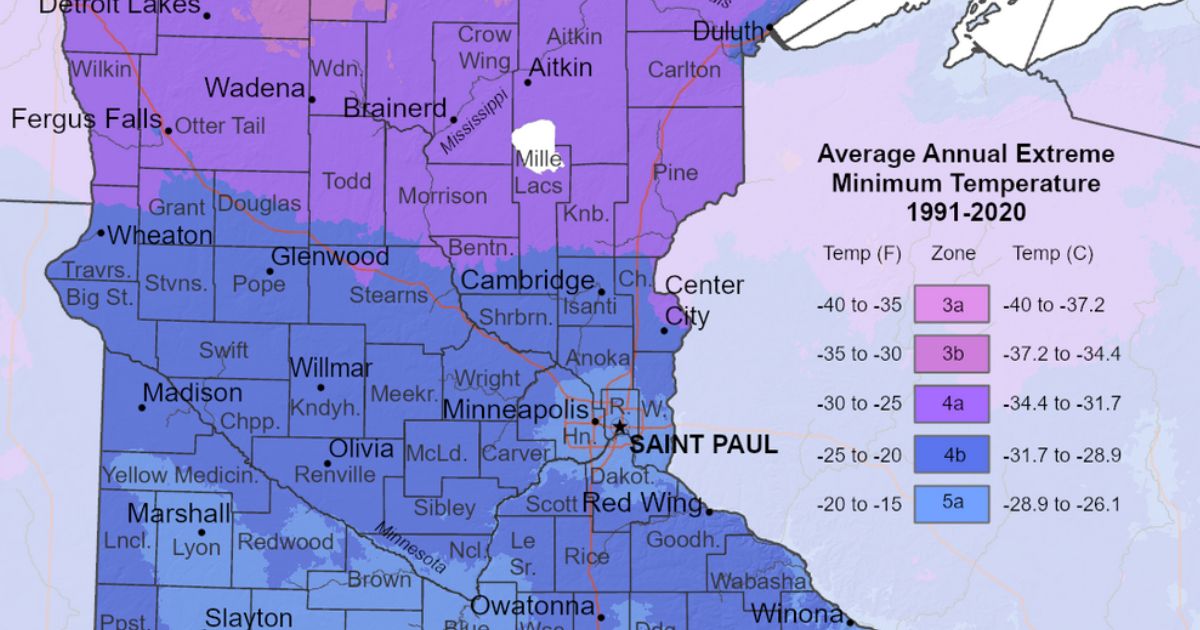10 Takeaways from the New Hardiness Zones Map
When the USDA-Agriculture Research Service and Oregon State University released the updated map of plant hardiness zones for the United States, there was a collective gasp heard across Minnesota. “What! So much of our state is now zone 5? It cannot be.”

Let’s look deeper into how hardiness zones are determined and what the map means for home gardeners.
The map is much more precise than prior maps. This map was drawn with many more data points—more than 13,000 across the United States—than the 2012 map. With more data, it measured temperature distinctions based on things like lakes and rivers and urban heat islands (think parking lots, roof tops, etc.). The result is a more nuanced map. The new zones are due more to better data than changing weather or climate, according to the USDA.

- The map is based on 30-year averages. This cold-hardiness map measures the average lowest low temperature over the past 30 years (1991-2020). It’s not the lowest temperature ever in those 30 years or the lowest temperature it might be in the future. It’s just an average. See the chart for the average lowest low in each of the zones that cover Minnesota.
- You may be zone 5 while your friend nearby is zone 4. The new map puts significant parts of the Twin Cities as well as parts of southern and southwestern Minnesota in USDA Zone 5a. But most of those zone 5s are close to zone 4b—sometimes very close—both in temperature and proximity. So, Ivanhoe, MN, near the South Dakota border is rated 4b, while Russell, MN, only 17 miles away is 5a. The Minnesota Landscape Arboretum is still in zone 4b, but Paisley Park, just a five-minute drive away, is zone 5a.
- Minnesota’s zone 3 is shrinking. While a lot of attention has been given to the zone 5 ratings in Minnesota, zone 4 and zone 3 areas also changed. Zone 4 moved north. Zone 4b (the warm half of zone 4) has now shifted up past Glenwood in Pope County. Zone 3, which was once almost half of Minnesota, now covers about the northern quarter of the state, from the Canadian border to about Hubbard County. Grand Rapids is now in zone 4a.
- Zones are not the only factor in plant survival. Hardiness zones are used by plant companies to tell consumers where their plants will survive. Many plants just won’t survive temperatures in the -20s or lower. But other factors affect plant survival: soil, snow cover, early or late frosts, drought, wind, soil moisture and how long cold snaps last.
- Plant zone ratings are not 100 percent accurate.Plant companies try really hard to get the zone rating right for their plants. They don’t want customers complaining because something died. But the ratings are not perfect. My observation is that the companies tend to be conservative in ratings and that plants rated zone 4 may do just fine in zone 3, too. But not always and sometimes a plant rated for zone 4 really struggles in zone 4.
- Microclimate matters. Every garden has its own microclimate. Hedges, buildings with walls that face south, low spots or high points are among the factors that can make your garden warmer or colder than those around it. An outdoor thermometer or weather system is a good investment. Also, a rain gauge. If you decide to try higher zone plants in your garden, seek out one of those warm spots and plant them there.
- You will see more zone 5 plants in nurseries. Many gardeners in the heart of the Twin Cities have been growing Japanese maples, boxwood and other zone 5 plants for years. Nurseries will likely expand their zone 5 options, but remember when plants say zone 5, the companies usually rate them for the middle of the zone.
- Add up-zone plants conservatively. If you moved from zone 4 to zone 5 or zone 3 to zone 4, the new zone plants may survive in your garden. Plants from lower zones, however, are more likely to thrive. For key plants, such as trees or large shrubs, it might be safer to stick with your old zone.
- For native plants, consider eco-regions. Hardiness zones are not the only way to determine which plants to grow. The U.S. Environmental Protection Agency has a map of eco-regions that can also guide your planting. In fact, some argue it’s a better way to choose plants than hardiness zones because it takes into account pollinators and wildlife in an ecosystem. Ecoregions are areas with similar topography, soil and climate that tend to support similar plant and animal life. Wild Ones has a good explanation of why you might consider ecoregions.
The most important thing to remember is that your garden did not change, even if your zone did. Experienced gardeners know that winter low temperatures have moved upward in the past couple of decades, but if you love your garden as it is, don’t change it. If you want to try something new that’s only hardy to your new zone, go for it.
Mary Lahr Schier is a long-time Minnesota garden writer. Her website is mynortherngarden.com.


So VERY helpful!
I didn’t know about the eco-regions.
Mary, would you consider doing an online video conference class on the topic of changing growing zones and on eco-regions?
Kathy K.
Glad this was useful, Kathy! Just hared your webinar idea with Mary and our education team – fingers crossed. Thanks for the great feedback!